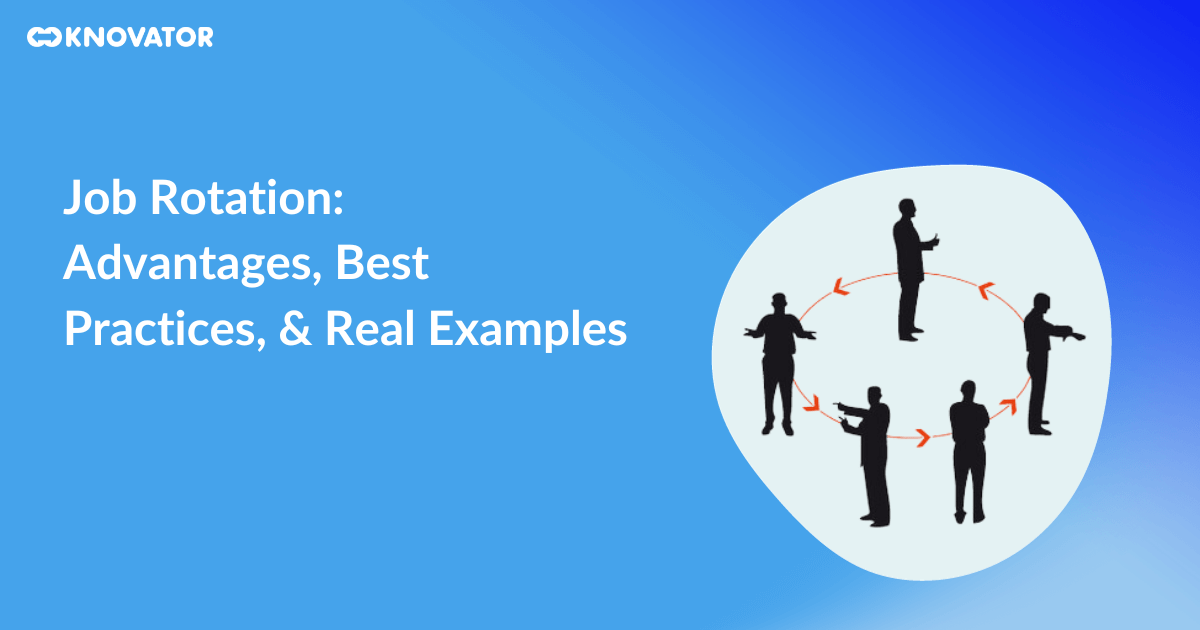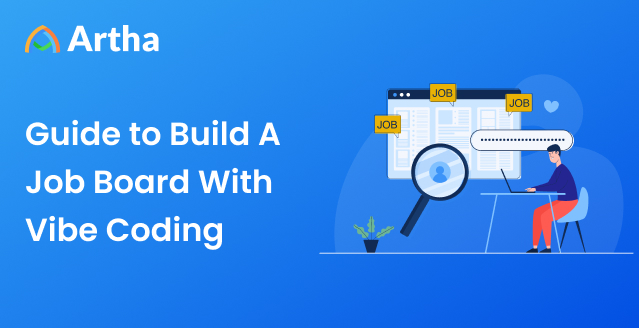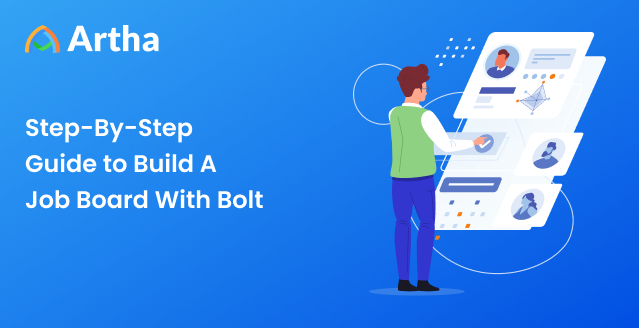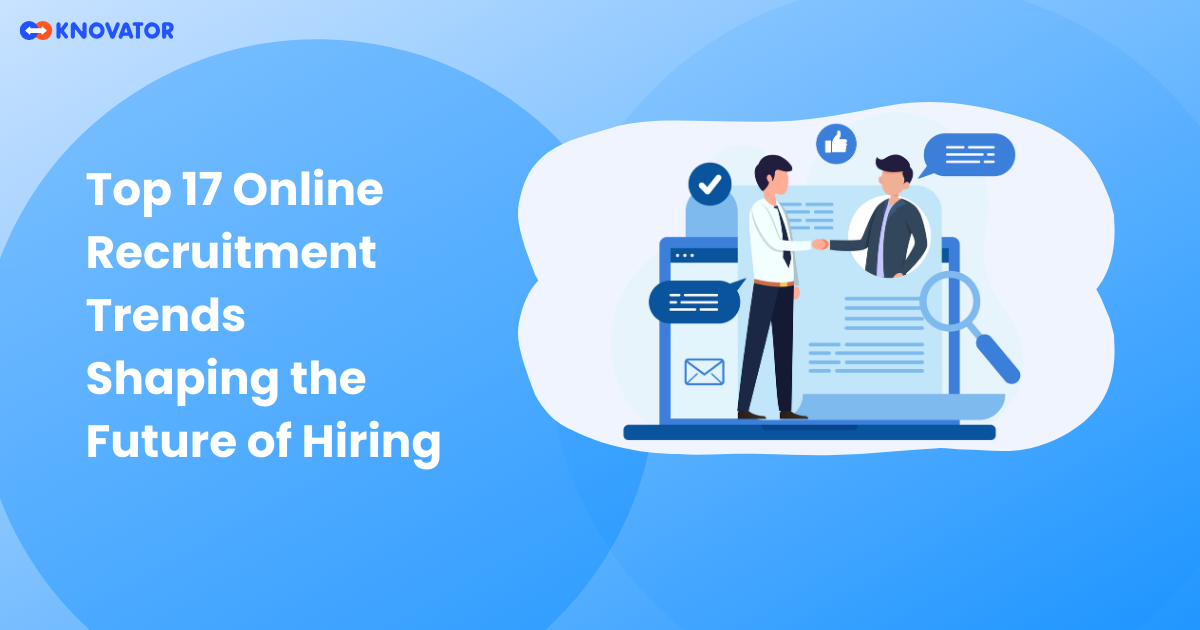Have you ever found employees bored with your job, craving new experiences and chances to learn? Doing the same thing every day can make a person feel stuck and unmotivated.
But there’s a solution that brings dynamism to the workplace: job rotation.
Don’t know much about it? You need not worry. Get ready to uncover the advantages of the practice and draw inspiration from real-world examples with the help of this blog.
We’ll delve into the world of job rotation, offering insights that can transform your organization’s approach to talent development. Let’s explore how embracing change can lead to a more engaged and skilled workforce.
What is Job Rotation?
Job rotation is a smart strategy that involves employees switching between different roles and tasks within an organization. This dynamic concept breathes life into routine work and brings fresh air to the workplace.
In simple terms, job rotation means employees get to work under different job roles, trying out various responsibilities instead of sticking to just one. It helps them learn new skills and prevents boredom from sneaking in. Imagine being a chef one day and a manager the next – that’s job rotation!
Now, why is this so important? Well, in today’s fast-paced business world, where innovation is the name of the game, job rotation is like a secret weapon. It helps employees understand how different company parts fit together, promoting a broader perspective. Plus, it’s like a skill-building adventure camp for employees. They gather a toolkit of skills from various roles, making them more adaptable and valuable.
Moreover, job rotation keeps employees engaged and motivated in an age where they crave growth and variety. It’s like a breath of fresh air that prevents burnout and nurtures a sense of exploration.
So, in this blog post, we’ll journey through the significance of job rotation in modern businesses, exploring how it’s more than just switching desks – it’s about nurturing a vibrant and versatile workforce.
Advantages of Job Rotation
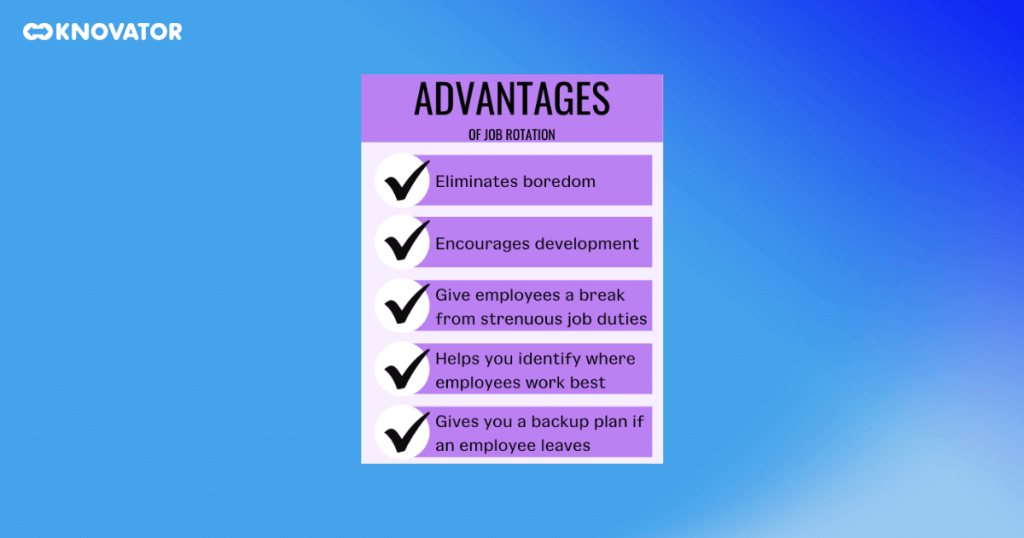
1. Better Employee Experience
Job rotation is a powerful tool that creates a better employee experience. One big perk is the chance to gain knowledge across various departments. Imagine an employee starting in marketing, then jumping to sales, and later in customer service – that’s like exploring different lands in the work world.
This diverse experience boosts their skills like nothing else. They will understand how different parts of the company operate, like getting a backstage pass to the business show. They learn the ropes in each area, making them well-rounded pros who can troubleshoot and innovate from different angles.
And guess what? When employers have a mix of skills, they become a master in the company’s eyes. They are not just confined to one job; they are a versatile player who can jump into any role!
Also Read: How to Boost Employee Performance with Emotional Intelligence
2. Higher Employee Motivation and Satisfaction
Job rotation boosts employees’ motivation and brings smiles to their faces. Employees who do different tasks don’t get stuck in the “same old, same old” routine. This variety makes work more interesting, like a series of exciting challenges.
When people take on new tasks, they feel valued and excited, which powers up their job performance. With each new role, they learn fresh skills.
So, when motivated, employers give their best work, making the company shine. They become superheroes with extra energy, and their satisfaction from conquering tasks boosts their happiness. This happiness spreads, creating a work atmosphere where everyone’s a winner.
Job rotation isn’t just moving people around – it’s like giving them a dose of enthusiasm that makes them and the company shine brighter.
3. Reduced Resignation Rates
Job rotation offers a sense of job security. When employees learn various skills, they become more valuable to the company, making them less likely to leave.
Also, it influences career growth. Employees with a broader skill set are better suited for promotions, keeping their eyes on the long-term prize. The positive attitudes stemming from job rotation make them feel valued and motivated, reducing the urge to explore opportunities elsewhere.
Job rotation is a strategic approach that yields significant advantages in talent retention. Rather than being a mere cycle of role changes, it functions as a robust retention mechanism.
4. Flexible Workforce
One of the top benefits of job rotation is creating a flexible and versatile workforce. When employees switch roles, they gather a toolkit of skills that can be used across various tasks. It’s like being able to play different musical instruments – employers are not limited to just one tune.
Job rotation isn’t just about moving employees around; it’s about creating a team of adaptable all-stars who can confidently tackle different tasks. This flexibility isn’t just a bonus – it’s necessary in today’s ever-changing business landscape. And job rotation is the training ground that makes it happen.
5. Higher Employee Engagement
By switching roles, employees escape the monotony trap. They face fresh challenges, learn new things, and feel part of something bigger. It keeps their enthusiasm alive and kicking. Plus, when people are engaged, they’re more likely to bring their best to work. They’re eager to conquer new frontiers, which boosts their performance.
When employers change tasks, the routine is not the same. They feel less stressed because each day is a new adventure. And when stress stays low, employees stay happier and healthier.
6. Better placement
Job rotation helps find the perfect spot for each employee. When they try different roles, it’s like trying out puzzle pieces until one fits just right. It enhances job satisfaction by aligning contented employees with roles that naturally complement their skill sets, resembling the seamless integration of puzzle pieces.
And that’s not all. Job rotation lights up a learning bonfire. Employees gather skills from different roles like a squirrel collects nuts. These skills make them versatile, and they can jump into different tasks like superheroes saving the day.
7. Improved Succession Planning
By exposing employees to diverse roles and responsibilities, job rotation creates a talent pool of versatile individuals capable of seamlessly stepping into higher positions. This proactive approach aids in minimizing the risks associated with unexpected workforce changes.
Furthermore, job rotation streamlines the process of identifying and nurturing potential successors. As employees gain exposure to different facets of the business, their skills, knowledge, and adaptability improve. It broadens their capabilities and ensures a smoother transition when leadership roles need to be filled.
Disadvantages of Job Rotation
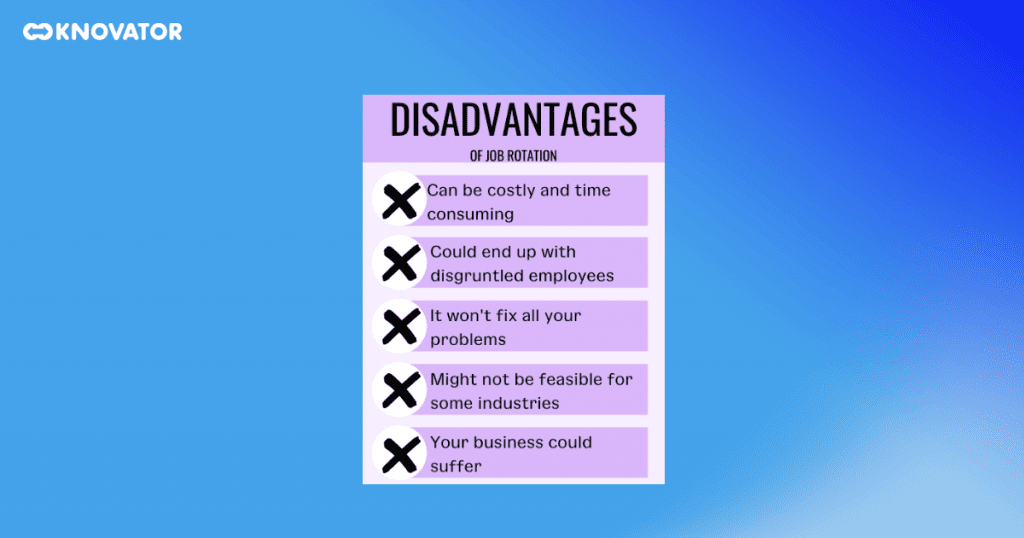
1. Requires Resources (Time & Money)
When companies introduce job rotation, it takes a big investment in time and money. They must create detailed training programs so employees can learn the skills for their new roles. It takes time away from normal work, making things slower. Also, while people are getting used to their new jobs, they need to be more productive. Plus, companies have to spend money on training materials for instructors and deal with the fact that things need to be more efficient during the transition.
2. Dissatisfied Employees
Job rotation can make employees unhappy, mostly because moving to new jobs can be uncomfortable. Getting used to different tasks and how things work can be tough initially. It might cause some issues in how smoothly the work gets done. Sometimes, the changes can also make it hard for teams to work well together. All these challenges can make employees feel not so great about their jobs, leading to them not being as excited to do their work and not doing it.
3. Not Enough Opportunities for Advancement
Even though job rotation is about trying new things, it can make employees feel like they need a chance to advance in their careers. They might think that always changing responsibilities stops them from getting good at one thing or becoming an expert. This feeling of being stuck can make them frustrated, and some might even decide to look for other opportunities. So, while job rotation is about learning different stuff, it might only sometimes match what people want when they’re looking to move forward in their careers.
Real-world Examples of Job Rotation
1. The Slumber Yard
The Slumber Yard is a leading online platform for mattress reviews. The company initiated a job rotation initiative to reduce employee turnover rates. Matthew Ross, the COO and co-owner, highlighted the program’s purpose, stating that equipping employees with proficiency across various areas could do away with the adverse impacts of staff leaving. In the event of an employee’s departure, the presence of other staff members capable of seamlessly transitioning into the vacant role becomes feasible.
Further, a quarterly rotation schedule is employed at The Slumber Yard, ensuring that individuals transition between roles approximately every three months.
2. Heineken
Look at another job rotation example from Heineken, the Dutch beer brewing company. They have special training programs for new graduates, like the Technologist Program. In this program, chosen trainees get different tasks, each lasting six months. It means they switch between departments like Packaging, Product Creation, Brewing, Quality Control, and Packaging Development.
The projects these trainees work on include:
- Making sure the products are safe and checking for quality risks.
- Creating new types of beer or new packaging ideas.
- Solving daily production issues by carefully studying and fixing them.
- Finding smart and new answers to new problems.
3. Edelman
Edelman, a PR and marketing firm in the US, has a special program for their top-performing employees with great potential. These chosen employees get to go to another country to work, live, and learn for up to 18 months.
The main purpose of Edelman’s program is to let people learn from different viewpoints worldwide and gain diverse work experience. This way, they can better help the company’s clients by bringing a broader perspective to their work.
Best Practices for Implementing Job Rotation
Let’s look at the best practices used to implement job rotation.
1. Clear Goal and Time Frame

Establish a clear time frame for the job rotation program. Determine how long employees will spend in each rotation, whether months or years and set milestones or review points along the way.
2. Preparation and Training

Offer training sessions to equip them with the necessary skills and knowledge for their new roles. Encourage open communication channels to address any concerns or questions, fostering a smooth transition and maximizing the benefits of job rotation.
3. Planning and Documentation
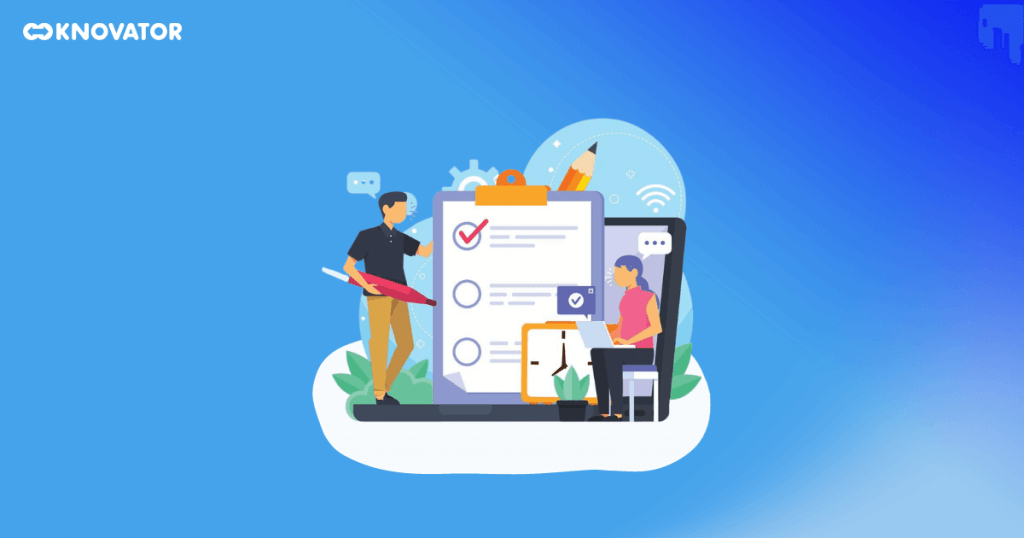
4. Timing of Rotation

5. Alignment with Career Paths

6. Measurable Objectives

7. Feedback Collection

Clear goals and a defined time frame provide direction and prevent confusion, while thorough preparation and training empower employees for success. A well-planned and documented approach minimizes inefficiencies, ensuring smooth transitions. Considering the timing of rotations in line with business seasons maintains productivity.
Moreover, aligning rotations with employees’ career paths enhances motivation and commitment. Setting measurable objectives offers a basis for performance evaluation and growth. Lastly, continuous feedback collection enables refinement, making the job rotation program more effective over time.
By following these practices, organizations can implement a robust job rotation program that enriches employees’ experiences and contributes to improved overall performance and growth.
Unlock Growth and Engagement: The Power of Job Rotation
Job rotation presents an exciting opportunity for employees to broaden their horizons and boost their career growth. Companies can create a win-win scenario by choosing best practices like setting clear goals, providing training, and aligning rotations with career aspirations.
Employees gain diverse skills and experiences, while organizations cultivate a versatile workforce capable of adapting to changing demands. A structured approach, including well-timed rotations and continuous feedback, further enhances the program’s effectiveness.
Through strategic job rotations, companies can empower their workforce, foster talent development, and propel individuals and organizations toward greater success.
